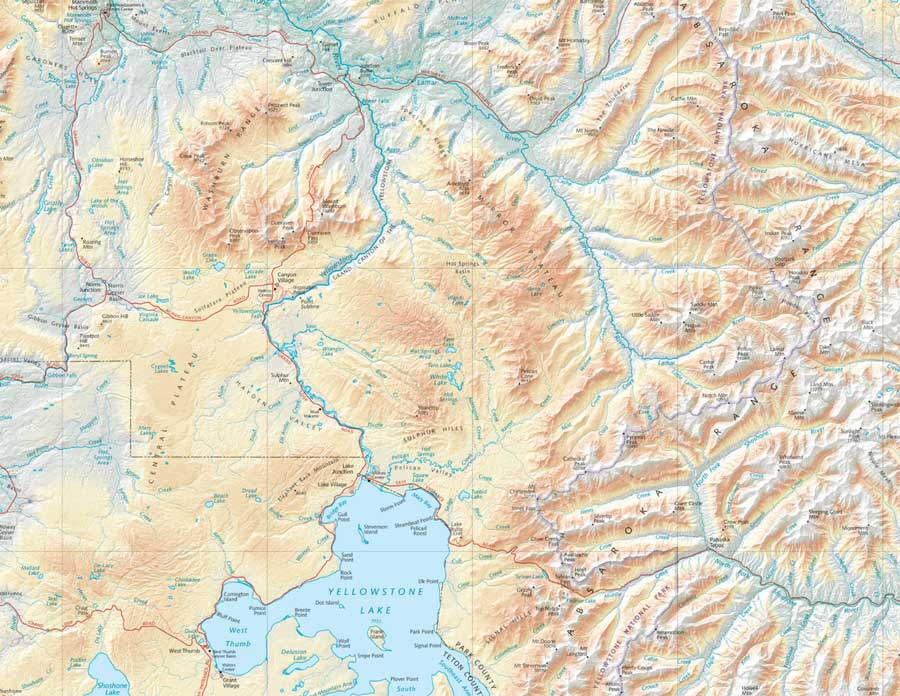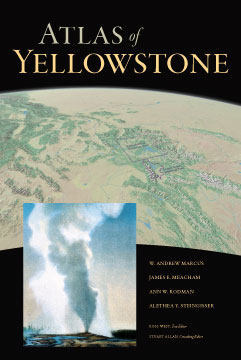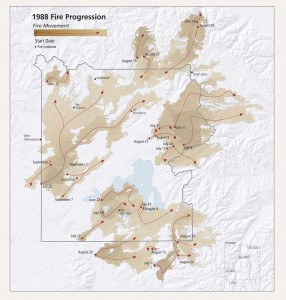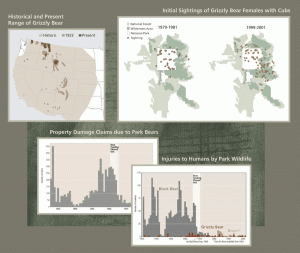
By Ruffin Prevost
CODY, WYO. — Where is Yellowstone National Park? That all depends on who you ask and how you define “Yellowstone.” But a newly published reference book aims to answer the question in as many ways as possible, using more than 800 maps with data-laden illustrations covering hundreds of major topics. The effort drew on the expertise of 130 contributors and spanned nearly a decade.
“Sometimes it felt like coordinating an army,” said Andrew Marcus, a University of Oregon professor of geography and senior editor of The Atlas of Yellowstone.

The comprehensive volume published by the University of California Press includes maps and informational graphics covering a dizzying array of topics, from animal migration routes to historic explorations, regional economies to wildland fires, vegetation patterns to mountain climbing.
Putting the book together required the work of more than 30 cartographers and four editors coordinating production on a volume that has close to 300 pages of meticulously rendered maps, illustrations, photographs and infographics, each answering the “Where is Yellowstone?” question with a different set of data, text and images.
The idea for The Atlas of Yellowstone grew out of a 2003 class project among advanced cartography students and faculty at the University of Oregon.
No one had ever created a comprehensive geographic atlas of Yellowstone before, partly because of the park’s location at the intersection of three states, but also because of the sheer scale of such a project.
“While discussing the upcoming class in a social setting, and emboldened by several microbrews, we decided that as long as we were doing a class on the topic, we might as well create an atlas of Yellowstone,” Marcus and co-editor James Meacham wrote in the book’s afterword. “This naive decision led us on a much more involved and lengthy journey than we ever imagined.”
The pair had originally considered focusing on the northern range of Yellowstone, a key animal migration corridor, Marcus said by telephone Wednesday from Eugene, Ore.
But Meacham pointed out that more than a century of research data covered the entire park, Marcus said, and breaking out figures for only a portion would probably prove more difficult than working with numbers for the whole park.
Where is Yellowstone? At the edges of other maps
“It’s one of the awful laws of cartography that anything you want to find will be at the corner of four different maps,” Marcus said with a laugh. “So we wanted to do something for the whole park.”
Eventually, the editors decided that to answer the question, “Where is Yellowstone?” they would have to survey the greater regional area, including Grand Teton National Park and surrounding communities, Marcus said.

Some maps in The Atlas of Yellowstone follow ecosystem boundaries, others look at the tri-state area of Idaho, Montana and Wyoming while still others include the entire Western United States. Illustrations tell the broad story of wolf migration across the wider region, for instance, as well as the microscopic scale of bacterial life in Yellowstone’s thermal features.
At the heart of the book are 84 “page pairs” — sets of facing pages that each weave a compelling tale about a single topic. Richly illustrated with detailed images and carefully interpreted data, the page pairs cover subjects like grizzly bears, the 1988 fires, early explorations and Yellowstone’s role as the wold’s first national park.
Other page pairs look at Yellowstone history, labor and employment, park visitation, art, early science history, glaciers, geysers, dinosaurs, bison, fish and the Yellowstone volcano, to list just a few subjects.
“They tell many different stories, and they’re designed to be beautiful as well as useful,” Marcus said.
Additional sections include a treasure trove of reference maps, a chapter on the origins of place names around Yellowstone and a gazetteer — a geographical index helping readers find specific places or features.
Though students, professionals and specialists working on the project came from diverse disciplines like cartography, illustration, biology and statistics, “we ended up as true geographers,” Marcus said.
Among the partners contributing time and expertise to the project were: Montana State University, Big Sky Institute, Museum of the Rockies, University of Wyoming and Buffalo Bill Historical Center.
The National Park Service and the Greater Yellowstone Science Learning Center also offered invaluable assistance, he said.
“The Park Service was incredibly generous in their willingness to provide data,” Marcus said, as well as in proofreading pages and helping to ensure the accuracy of The Atlas of Yellowstone.
Marcus estimated that the entire project cost more than $500,000. But editors and contributors will not receive royalties from sales of The Atlas of Yellowstone, which is set up as a nonprofit endeavor. Many of those who worked on the book volunteered much of their time.
“This is the work of people that love Yellowstone,” Marcus said. “It’s not about making a profit.”
Funding partners included the universities, the Yellowstone Park Foundation and Canon U.S.A.
Where is Yellowstone? On paper, maybe in bits and bytes
In an age when smartphone apps and websites can help Yellowstone visitors find roadside attractions, hotel discounts and even wandering wildlife, it may seem quaint to spend so much time and effort on that centuries-old information delivery system known as the book.
But paper never suffers from a dead battery or lack of cell phone service, issues that are more common in Yellowstone than most other places. And an Atlas of Yellowstone website or smartphone app hasn’t been ruled out, Marcus said.

“That partly depends on how well the book sells,” he said. “You need all your materials in the book first, then you can begin to consider repacking and changing them in ways that work well online. There’s no app yet, but we’ve definitely talked about ideas along that line.”
Maps, charts, illustrations and graphs can go a long way toward answering the question, “Where is Yellowstone?” But the broader answer can be found in themes that run throughout The Atlas of Yellowstone, Marcus said.
Yellowstone is changing over timespans of millions of years and within each new season, as well as on spatial scales from the microscopic to the tectonic. So one theme of the book is how the park varies in time and space. The park also exists in a broader context of influence that travels far beyond its boundaries or core ecosystem, because it is connected to the wider world in ways like animal migration patterns and in the hearts and minds of its visitors. The Atlas of Yellowstone also explores the connection between humans and nature, looking at the effect of people on the park and of the park on people.
Where is Yellowstone? For those who know and love the world’s first national park, it’s a place where you’re always seeking to stay a little longer or return for another visit. But in a way, you might also find it between the covers of a book.
The Atlas of Yellowstone is available online and in local bookstores for a suggested retail price of $65.
Contact Ruffin Prevost at 307-213-9818 or [email protected].

The Park County Library in Cody has this book now in its reference department if anyone wants to look at it in the library. Click here to view the record in the online catalog.